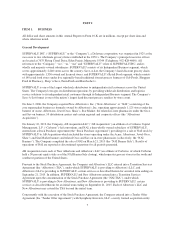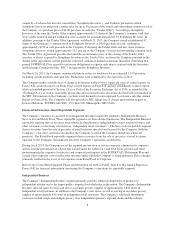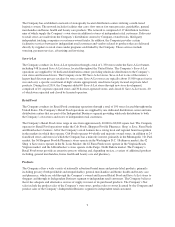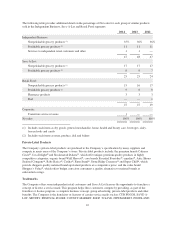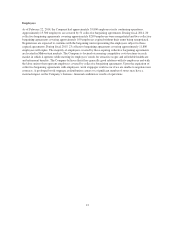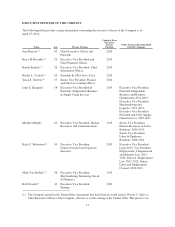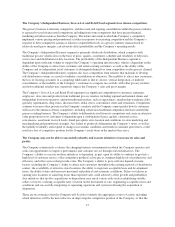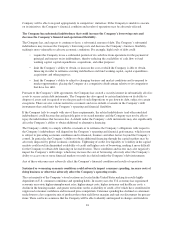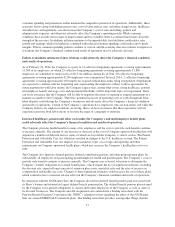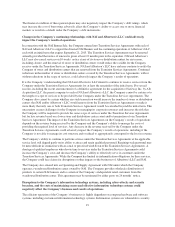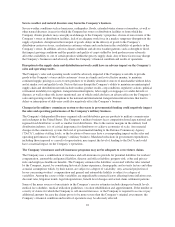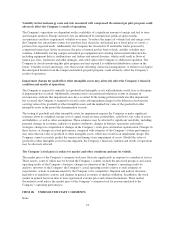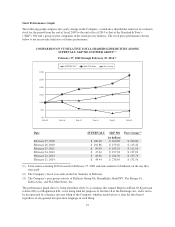Albertsons 2014 Annual Report Download - page 19
Download and view the complete annual report
Please find page 19 of the 2014 Albertsons annual report below. You can navigate through the pages in the report by either clicking on the pages listed below, or by using the keyword search tool below to find specific information within the annual report.consumer spending and preferences and/or maintain the competitive position of its operations. Additionally, these
economic factors along with higher interest rates, costs of labor and tax rates, and other changes in tax, healthcare
and other laws and regulations, can also increase the Company’s cost of sales and selling, general and
administrative expenses, and otherwise adversely affect the Company’s operating results. While economic
conditions have recently shown signs of improvement and less volatility, there is continued uncertainty about the
strength of the recovery. In addition, inflation continues to be unpredictable; food deflation could reduce sales
growth and earnings, while food inflation, combined with reduced consumer spending, could reduce gross profit
margins. If these consumer spending patterns continue or worsen, and the economy does not continue to improve or
it weakens, the Company’s financial condition and results of operations may be adversely affected.
Failure to maintain satisfactory labor relations could adversely affect the Company’s financial condition
and results of operations.
As of February 22, 2014, the Company is a party to 51 collective bargaining agreements covering approximately
15,300 of its employees, of which 23 collective bargaining agreements covering approximately 11,800
employees are scheduled to expire in fiscal 2015. In addition, during fiscal 2014, 20 collective bargaining
agreements covering approximately 8,200 employees were renegotiated. In fiscal 2014, 2 collective bargaining
agreements covering approximately 100 employees expired without their terms being renegotiated. Negotiations
are expected to continue with the bargaining units representing the employees subject to those agreements. In
future negotiations with labor unions, the Company expects that, among other issues, rising healthcare, pension
and employee benefit and wage costs and operational flexibility will be important topics for negotiation. There
can be no assurance that the Company will be able to negotiate the terms of expiring or expired agreements in a
manner acceptable to the Company. Therefore, potential increases in operating costs or work disruptions from
labor disputes could disrupt the Company’s businesses and adversely affect the Company’s financial condition
and results of operations. Certain of the Company’s operations have employees who are non-union, and while the
Company believes its employee relations are strong, there can be no assurance that these operations will not
experience pressure from labor unions or become the target of campaigns to unionize.
Increased healthcare, pension and other costs under the Company’s and multiemployer benefit plans
could adversely affect the Company’s financial condition and results of operations.
The Company provides health benefits to many of its employees and the costs to provide such benefits continue
to increase annually. The amount of any increase or decrease in the cost of Company-sponsored health plans will
depend on a number of different factors, many of which are beyond the Company’s control, such as The Patient
Protection and Affordable Care Act which has resulted in changes to the U.S. healthcare system. The Patient
Protection and Affordable Care Act imposes new mandatory types of coverage and reporting and other
requirements on Company-sponsored health plans, which may increase the Company’s health plan costs over
time.
The Company also sponsors defined pension, defined contribution pension, and other postretirement plans for
substantially all employees not participating in multiemployer health and pension plans. The Company’s costs to
provide such benefits continue to increase annually. The Company uses actuarial valuations to determine the
Company’s benefit obligations for certain benefit plans, which require the use of significant estimates, including
the discount rate, expected long-term rate of return on plan assets, mortality rates and the rates of increase in
compensation and health care costs. Changes to these significant estimates could increase the cost of these plans,
which could also have a material adverse effect on the Company’s financial condition and results of operations.
In connection with the NAI Banner Sale, the Company divested its defined benefit pension plan associated with
its Shaw’s banner and retained its largest defined benefit pension plan. The defined benefit pension plan retained
by the Company is for pension obligations to current and former employees of the Company as well as some of
its divested businesses. The Company and AB Acquisition also entered into a binding term sheet with the
Pension Benefit Guaranty Corporation (the “PBGC”) relating to issues regarding the effect of the NAI Banner
Sale on certain SUPERVALU retirement plans. The binding term sheet provides, among other things, that the
17


